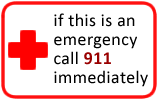Spider Bite
Spider Bite
Does this describe your symptoms? |
Click image for more info |
Definition
General Information
Black Widow Spider Bite
Brown Recluse Spider Bite
Tarantulas
Minor (Non-Dangerous) Spider Bites
|
If not, see these topics
|
When to Call Your Doctor |
Call 911 Now (you may need an ambulance) If |
|
|
|
Call Your Doctor Now (night or day) If |
|
|
|
Call Your Doctor Within 24 Hours (between 9 am and 4 pm) If |
|
|
|
Call Your Doctor During Weekday Office Hours If |
|
|
|
Self Care at Home If |
|
|
HOME CARE ADVICE |
Non-Serious Spider Bite
Cleansing: Wash the bite thoroughly with soap and water.
Pain Medicines:
For pain relief, take acetaminophen, ibuprofen, or naproxen.
Acetaminophen (e.g., Tylenol):
Take 650 mg by mouth every 4-6 hours. Each Regular Strength Tylenol pill has 325 mg of acetaminophen.
Another choice is to take 1,000 mg every 8 hours. Each Extra Strength Tylenol pill has 500 mg of acetaminophen.
The most you should take each day is 3,000 mg.
Ibuprofen (e.g., Motrin, Advil):
Take 400 mg by mouth every 6 hours.
Another choice is to take 600 mg by mouth every 8 hours.
Use the lowest amount that makes your pain feel better.
Naproxen (e.g., Aleve):
Take 250-500 mg by mouth every 12 hours.
Use the lowest amount that makes your pain feel better.
Extra Notes:
Acetaminophen is thought to be safer than ibuprofen or naproxen in people over 65 years old. Acetaminophen is in many OTC and prescription medicines. It might be in more than one medicine that you are taking. You need to be careful and not take an overdose. An acetaminophen overdose can hurt the liver.
Caution: Do not take acetaminophen if you have liver disease.
Caution: Do not take ibuprofen or naproxen if you have stomach problems, kidney disease, are pregnant, or have been told by your doctor to avoid this type of medicine. Do not take ibuprofen or naproxen for more than 7 days without consulting your doctor.
Before taking any medicine, read all the instructions on the package
Expected Course: Some swelling and pain for 1 to 2 days. It shouldn't be any worse than a bee sting.
Call Your Doctor If:
Severe bite pain persists longer than 2 hours after pain medicine
Abdominal pains or muscle spasms occur
Local pain lasts more than 2 days (48 hours)
Bite begins to look infected
You become worse
Preventing Spider Bites
Prevention - Outdoors:
Be especially careful around wood piles and when clearing brush.
Wear long pants with the pants tucked into your socks.
Wear long-sleeved shirts and use gloves.
DEET is a very effective insect repellent. It also repels spiders.
Prevention - Indoors:
Remove spider webs.
Make certain that doorways and windows are effectively sealed and insulated.
Using DEET-Containing Insect Repellents When Outdoors:
DEET is a very effective insect repellent. It also repels spiders.
Higher concentrations of DEET do work better - but there appears to be no benefit in using DEET concentrations above 50%. For children and adolescents, the American Academy of Pediatrics recommends a maximum concentration of 30%. Health Canada recommends using a concentration of 5-30% for adults.
Apply to exposed areas of skin. Do not apply to eyes, mouth or irritated areas of skin. Do not apply to skin that is covered by clothing.
Remember to wash it off with soap and water when you return indoors.
DEET can damage clothing made of synthetic fibers, plastics (e.g., eye glasses), and leather.
Breastfeeding women may use DEET. No problems have been reported. (CDC 2003)
And remember, contact your doctor if you develop any of the "Call Your Doctor" symptoms.
Updated:
March 22, 2017





